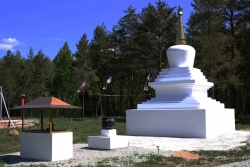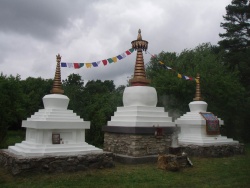Sacred Space
by Julia Hardy
The earliest example of sacred space in Buddhism is the stupa. Early accounts indicate that the Buddha's cremated remains were first placed under a mound at a crossroads, and then removed and divided among a number of Buddhist groups (some sources say
eight, some say eleven, some say twelve), each of which enshrined their portion of the relics in a stupa. According to legend, the great king Ashoka later divided these remains and distributed them to 84,000 stupas throughout his realm and beyond.
In the first centuries of Buddhist presence in South and Southeast Asia, monuments were also built to mark important moments in the Buddha's life such as his place of birth or the location of his first sermon. Ashoka started the practice of making
pilgrimage to these sites, a practice that was taken up by many of the faithful. With time, large temple complexes grew up around these stupas.
Later, stupas were also built to house the remains of famous monks, sometimes containing their cremated remains, and on rare occasions, the entire mummified body of a monk who had died while deep in meditation. Stupas were believed to radiate the presence of the person whose remains were enshrined there, as the enlightened mind was believed to continue even after the body was gone.
Eventually the stupa itself was regarded as a manifestation of the sacred, and many different types of objects were placed within them. As Buddhism expanded in South and Southeast Asia, temple complexes grew up around some of these stupas. Elaborate stone
railings were built around the stupas, upon which moments in the life of the Buddha and the Jataka tales were carved. To walk around these railings was to recreate the experience of these events, almost as if one were actually there. While the Buddha himself was no longer physically present, he was kept alive for the faithful in these sacred places.
The Great Temple at Borobudur, in Java, Indonesia, is in essence an enormous stupa that represents the cosmos. Built sometime during the 8th or 9th centuries C.E., the temple was lost for centuries, but was rediscovered in the 18th century. The base of the Great Temple is a pyramid shape, within which are five concentric square terraces. Above the base is a cone-shaped core surrounded by three
circular platforms, around which are seventy-two openwork stupas, each containing a statue of the Buddha. The entire building is topped by another, larger stupa. Pilgrims circumambulate the many levels of the temple at Borobudur as an act of devotion. All along the way they encounter statues of the Buddha and stone carvings representing the stories of Buddha's past lives from the [[Jataka
tales]], as well as reliefs that depict the operations of cause and effect. Thus a journey around Borobudur was an experience of the life and teachings of the Buddha.
In time, small, portable stupas were also created as objects of veneration or meditation. One form of Tibetan Buddhist meditation involves building a small multi-layered stupa out of sand, rock, and small metal platforms, holding the stupa in one hand
while adding to it with the other. If during the process one's stupa falls apart, one must begin again at the beginning. Japanese Buddhists once used a stupa form that they call gorinto, with one layer for each of the five elements, to create grave markers for important figures.
Another kind of sacred space in Buddhism is the mountain. There are legendary mountains such as Mount Meru, believed to be the abode of the gods, and Vulture Peak, where the Buddha was said to have preached the Lotus Sutra, and where, according to the
sutra, the Buddha still resides and teaches. There are also physical mountains that have become the loci of monasteries, hermit dwellings, and shrines, and are often visited by lay Buddhists. These mountains are a meeting place between heaven and earth, and those who climb them or live upon them are believed to have access to the sacred.
Buddhist monasteries and temples throughout Asia also contain sacred spaces. That is not to say that every area within a temple complex is sacred; one might run across a flea market or a snack stand within, but there are many spaces inside that have an aura of
sanctity. These might include meditation areas for monks, buildings that house statues of deities, ritual spaces, rooms in which tablets commemorating the deceased are kept, and cemeteries.
There are many characteristics that contribute to the aura of sacredness that permeates the temple complex. The architecture of the buildings is often inspiring, with brilliantly decorated ceilings, passageways, and rooftops. Most temples have at least one multi-storied pagoda with rooftop upon rooftop vaulting upward into the sky. One will see statues of deities and religious paintings in many of the buildings.
Historic temples may also contain museums where one can see scrolls, paintings, statues, and ritual implements, some over a thousand years old. The temple grounds are beautifully kept and may include flower or rock gardens, small lakes, mossy forests, or stately old trees.
One of the fascinating things about Buddhist temple complexes is the number of activities that may be occurring simultaneously, some religious and some secular. One can see drifting incense and hear the sound of chanting emerging from one building, and enter another to see a statue that may be over a thousand years old. Outside one may see a group of school children on a field trip, or encounter a young
couple in love on a date. There may be a souvenir stand where one can purchase good luck talismans, and another small building where a Buddhist monk will tell your fortune for a small fee. The temple complex provides a total aesthetic experience that conveys mystery, joy, playfulness, hope, solemnity, and beauty.
sacred space: "A space that is recognized with heart and mind, that radiates a particular atmosphere you cannot help but feel." "if you regard...space as sacred, if you care for it with your heart and mind, then it will be a palace."

